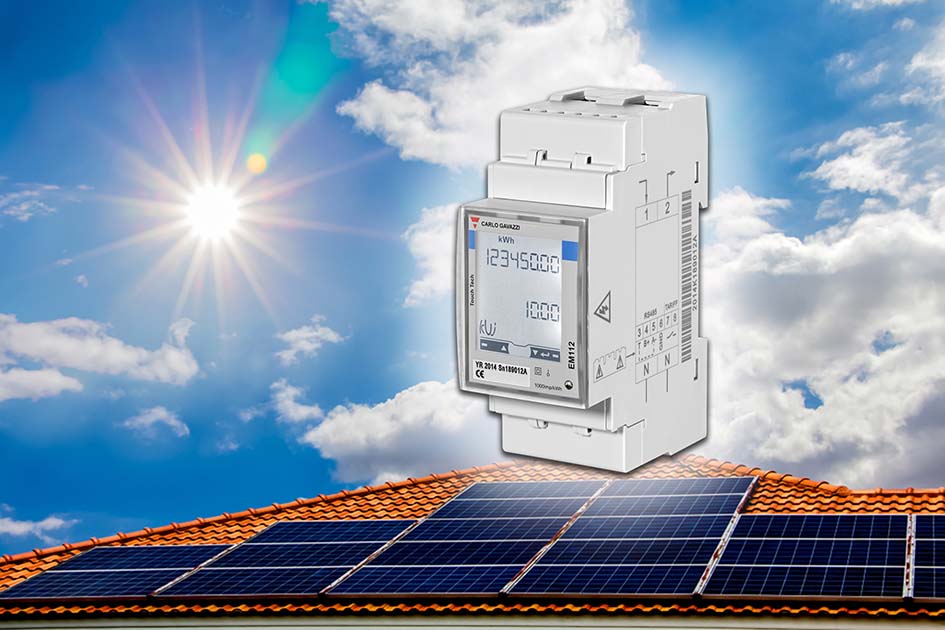SOLAR SO GOOD
Posted in Carlo Gavazzi Controls by Alison on April 14th 2020

Lark Rise is an award-winning ultra-low energy, all-electric, contemporary home situated on the edge of the Chiltern Hills in Buckinghamshire. It is also one of the most advanced homes in England. Designed by bere:architects, it incorporates a 12.4kW Photovoltaic array on the roof and a 13.8kWh battery to store excess electricity not used by the house that would otherwise be exported to the grid.
After two years of monitoring, the results show that the house generates twice as much energy as it consumes each year and exports 10 times as much energy as it imports – it acts as a tiny renewable energy power station. An increasing proportion of the UK electricity is being supplied by renewables. The contribution of Lark Rise is minuscule compared to the increasing number of wind and solar farms that supply the grid.
An electrical grid powered by renewables has the potential to turn electricity pricing strategies on their head. At the moment, generating capacity is turned on and off to meet demand. But renewables cannot be switched on and off and so demand will increasingly have to follow supply. That means harvesting energy when renewables are providing and trying to minimise energy use when that is not the case.
In practice, what this means is that a householder who can be flexible in their electrical demand can have a significant impact on both their carbon intensity and potentially the price they pay for power. Using domestic battery storage can provide households with the flexibility needed to help match the demand profile of a home with the grid and with on-site generation as bere:architects have successfully demonstrated with Lark Rise.
The solar battery market is rapidly growing as more manufacturers start looking at ways to innovate and drive down costs. Controls too are becoming more sophisticated. Victron Energy, for example, produce a grid-parallel energy storage system, designed to work with battery storage systems. This includes a Carlo Gavazzi energy meter to monitor and measure power import/export so the system knows when to charge or discharge the battery to increase self-sufficiency. It system can also be operated remotely via a browser or App.
Metering is an essential part of any battery storage installation and Carlo Gavazzi is receiving a significant upsurge in interest. Solar PV panels generate direct current (DC) and an inverter is needed to convert this DC to alternating current (AC). A generation meter is required to record the kWh generated and used in the home or business or is exported to the grid.
The batteries in a solar PV storage system work like any rechargeable battery: they charge using direct current (DC) from an external source (the solar PV system) and discharge DC when energy is required. DC also has to be converted to AC by an inverter. The meter is used to measure export/import so the system knows when to charge/discharge the battery in order to increase self-sufficiency.
There are two main ways of linking battery storage into a solar PV system and useful guidance is available from the Building Research Establishment (BRE) and others:
- DC coupled: the batteries are installed on the same side of the inverter as the solar PV panels; they charge from the panels, and their DC is only converted to AC when it’s used
- AC coupled: the batteries are installed on the grid-side, where the solar PV’s DC has already been converted to AC. A separate inverter converts the AC back to DC for storing in the battery. When the battery discharges, the same separate inverter converts the DC back to AC.
An AC-coupled system is more appropriate when adding battery storage to an existing solar PV system and in such retrofit applications the installer will need to verify that the new equipment being installed is compatible with the existing equipment, says the BRE.
New projects tend to be DC-coupled, but there are some important considerations. Many DC-coupled systems will not operate in a power-cut and they may affect FIT income. In DC-coupled battery storage systems, the solar electricity that goes to charge the batteries isn’t registered by the generation meter at the time, but only when it is subsequently discharged by the batteries or when the batteries are full. Since all batteries lose energy in the charge-discharge cycle, some of the original solar PV output will be lost in the process. This will impact on FIT payments. However, the savings available through buying less electricity will still be significantly greater than the loss of export tariff, claims the BRE.
From grid-connected energy storage such as E.ON’s £4 million facility, located at Willenhall substation near Wolverhampton, through to the likes of Tesla and Nissan’s products for the domestic sector, this is a market set to soar. Energy managers are advised to make sure they’re a part of it.
Enjoyed this post? Share it!
Share this article:





















